Business Finance Report: Financial Statement Analysis and Ratios
VerifiedAdded on 2022/11/24
|16
|2693
|67
Report
AI Summary
This report provides a comprehensive analysis of business finance, focusing on financial management principles, financial statements, and ratio analysis. It begins with an introduction to financial management, its importance, and key concepts. The main body delves into financial statements, including the income statement and balance sheet, and the utilization of various financial ratios such as profitability, liquidity, and efficiency ratios. The report includes a case study with completed financial information, ratio calculations, and an assessment of the company's financial performance. Finally, it outlines processes and strategies to improve financial performance, including cost reduction, inventory management, and revenue enhancement. The report aims to provide insights into financial analysis and decision-making.
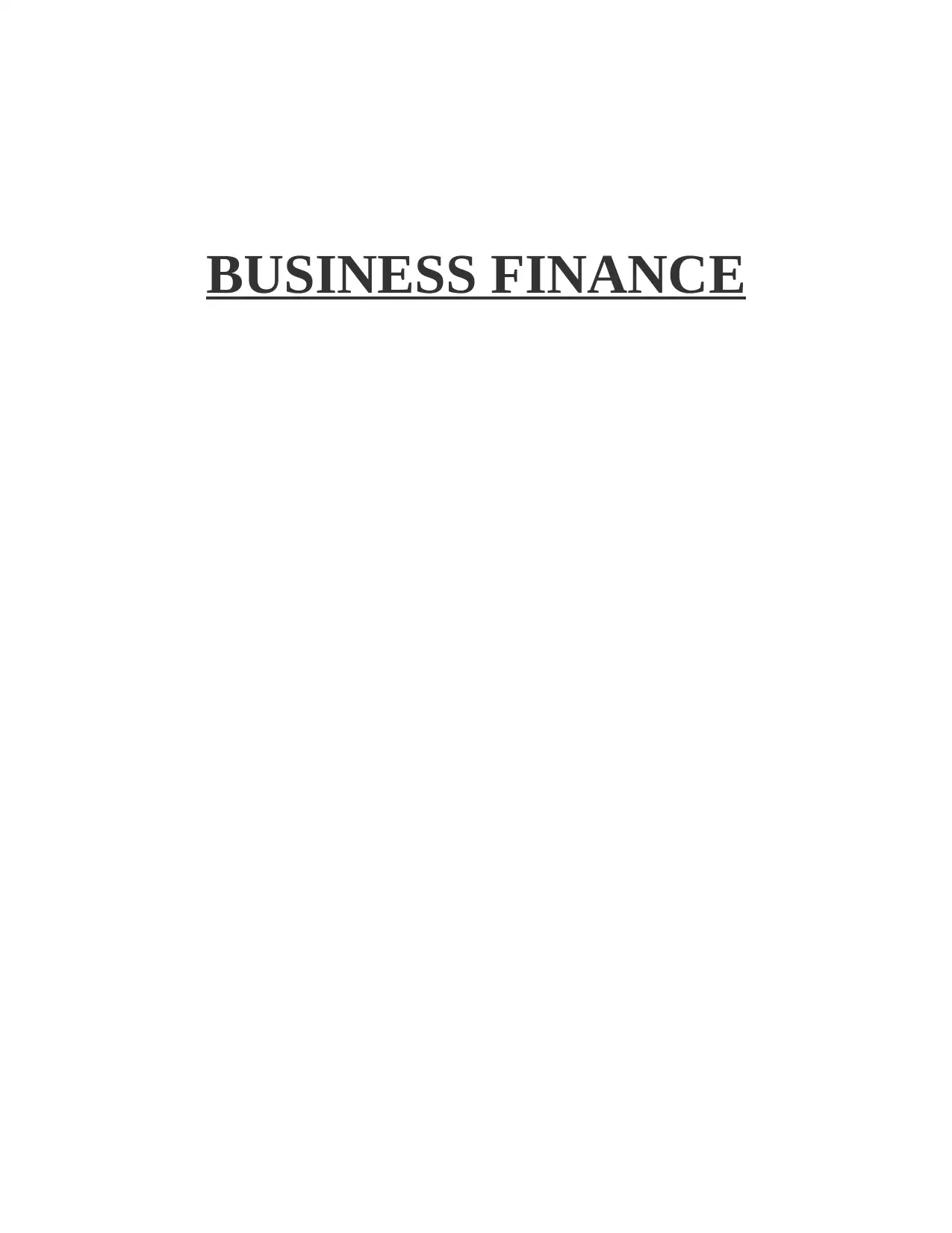
BUSINESS FINANCE
Paraphrase This Document
Need a fresh take? Get an instant paraphrase of this document with our AI Paraphraser
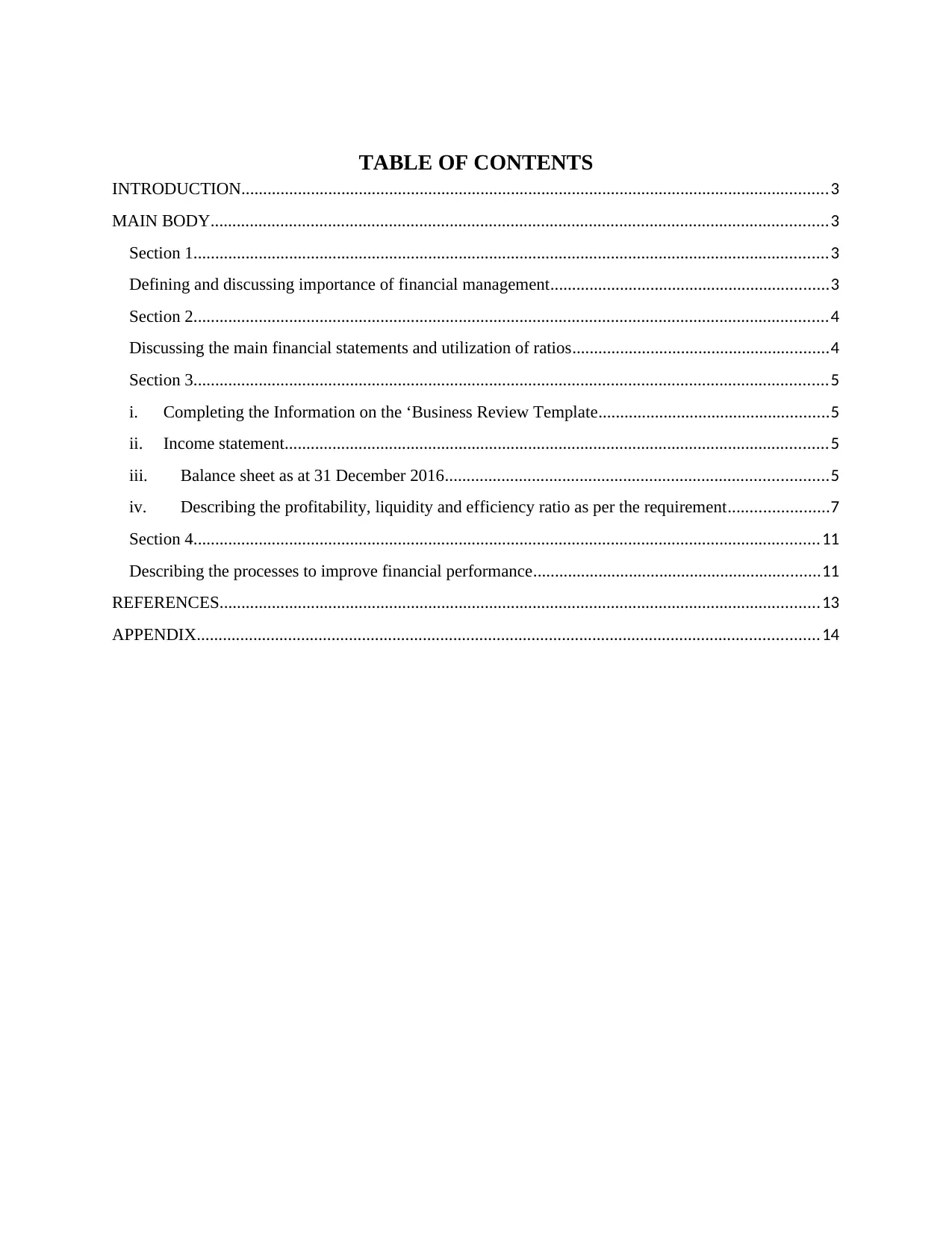
TABLE OF CONTENTS
INTRODUCTION.......................................................................................................................................3
MAIN BODY..............................................................................................................................................3
Section 1..................................................................................................................................................3
Defining and discussing importance of financial management................................................................3
Section 2..................................................................................................................................................4
Discussing the main financial statements and utilization of ratios...........................................................4
Section 3..................................................................................................................................................5
i. Completing the Information on the ‘Business Review Template.....................................................5
ii. Income statement.............................................................................................................................5
iii. Balance sheet as at 31 December 2016........................................................................................5
iv. Describing the profitability, liquidity and efficiency ratio as per the requirement.......................7
Section 4................................................................................................................................................11
Describing the processes to improve financial performance..................................................................11
REFERENCES..........................................................................................................................................13
APPENDIX...............................................................................................................................................14
INTRODUCTION.......................................................................................................................................3
MAIN BODY..............................................................................................................................................3
Section 1..................................................................................................................................................3
Defining and discussing importance of financial management................................................................3
Section 2..................................................................................................................................................4
Discussing the main financial statements and utilization of ratios...........................................................4
Section 3..................................................................................................................................................5
i. Completing the Information on the ‘Business Review Template.....................................................5
ii. Income statement.............................................................................................................................5
iii. Balance sheet as at 31 December 2016........................................................................................5
iv. Describing the profitability, liquidity and efficiency ratio as per the requirement.......................7
Section 4................................................................................................................................................11
Describing the processes to improve financial performance..................................................................11
REFERENCES..........................................................................................................................................13
APPENDIX...............................................................................................................................................14
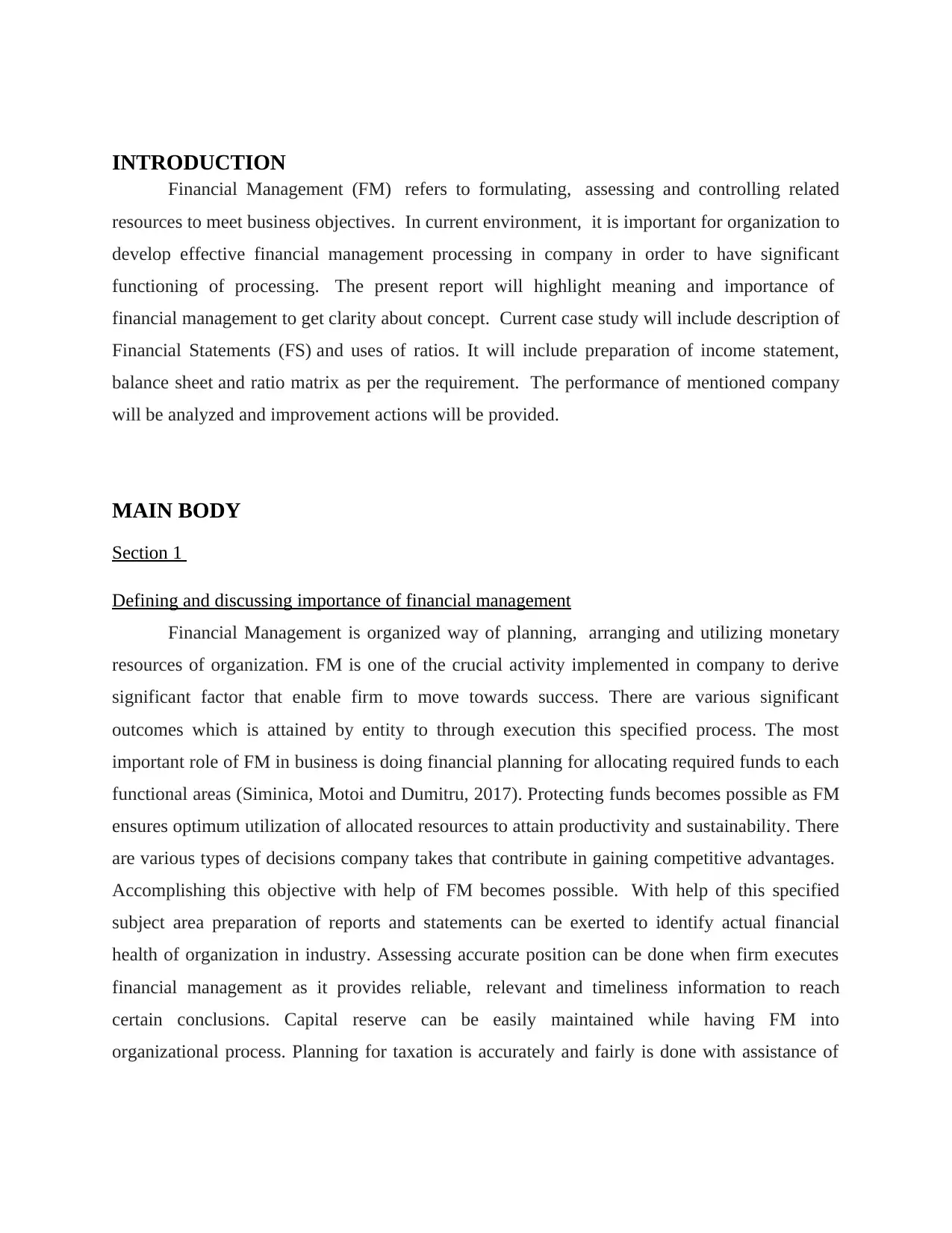
INTRODUCTION
Financial Management (FM) refers to formulating, assessing and controlling related
resources to meet business objectives. In current environment, it is important for organization to
develop effective financial management processing in company in order to have significant
functioning of processing. The present report will highlight meaning and importance of
financial management to get clarity about concept. Current case study will include description of
Financial Statements (FS) and uses of ratios. It will include preparation of income statement,
balance sheet and ratio matrix as per the requirement. The performance of mentioned company
will be analyzed and improvement actions will be provided.
MAIN BODY
Section 1
Defining and discussing importance of financial management
Financial Management is organized way of planning, arranging and utilizing monetary
resources of organization. FM is one of the crucial activity implemented in company to derive
significant factor that enable firm to move towards success. There are various significant
outcomes which is attained by entity to through execution this specified process. The most
important role of FM in business is doing financial planning for allocating required funds to each
functional areas (Siminica, Motoi and Dumitru, 2017). Protecting funds becomes possible as FM
ensures optimum utilization of allocated resources to attain productivity and sustainability. There
are various types of decisions company takes that contribute in gaining competitive advantages.
Accomplishing this objective with help of FM becomes possible. With help of this specified
subject area preparation of reports and statements can be exerted to identify actual financial
health of organization in industry. Assessing accurate position can be done when firm executes
financial management as it provides reliable, relevant and timeliness information to reach
certain conclusions. Capital reserve can be easily maintained while having FM into
organizational process. Planning for taxation is accurately and fairly is done with assistance of
Financial Management (FM) refers to formulating, assessing and controlling related
resources to meet business objectives. In current environment, it is important for organization to
develop effective financial management processing in company in order to have significant
functioning of processing. The present report will highlight meaning and importance of
financial management to get clarity about concept. Current case study will include description of
Financial Statements (FS) and uses of ratios. It will include preparation of income statement,
balance sheet and ratio matrix as per the requirement. The performance of mentioned company
will be analyzed and improvement actions will be provided.
MAIN BODY
Section 1
Defining and discussing importance of financial management
Financial Management is organized way of planning, arranging and utilizing monetary
resources of organization. FM is one of the crucial activity implemented in company to derive
significant factor that enable firm to move towards success. There are various significant
outcomes which is attained by entity to through execution this specified process. The most
important role of FM in business is doing financial planning for allocating required funds to each
functional areas (Siminica, Motoi and Dumitru, 2017). Protecting funds becomes possible as FM
ensures optimum utilization of allocated resources to attain productivity and sustainability. There
are various types of decisions company takes that contribute in gaining competitive advantages.
Accomplishing this objective with help of FM becomes possible. With help of this specified
subject area preparation of reports and statements can be exerted to identify actual financial
health of organization in industry. Assessing accurate position can be done when firm executes
financial management as it provides reliable, relevant and timeliness information to reach
certain conclusions. Capital reserve can be easily maintained while having FM into
organizational process. Planning for taxation is accurately and fairly is done with assistance of
⊘ This is a preview!⊘
Do you want full access?
Subscribe today to unlock all pages.

Trusted by 1+ million students worldwide
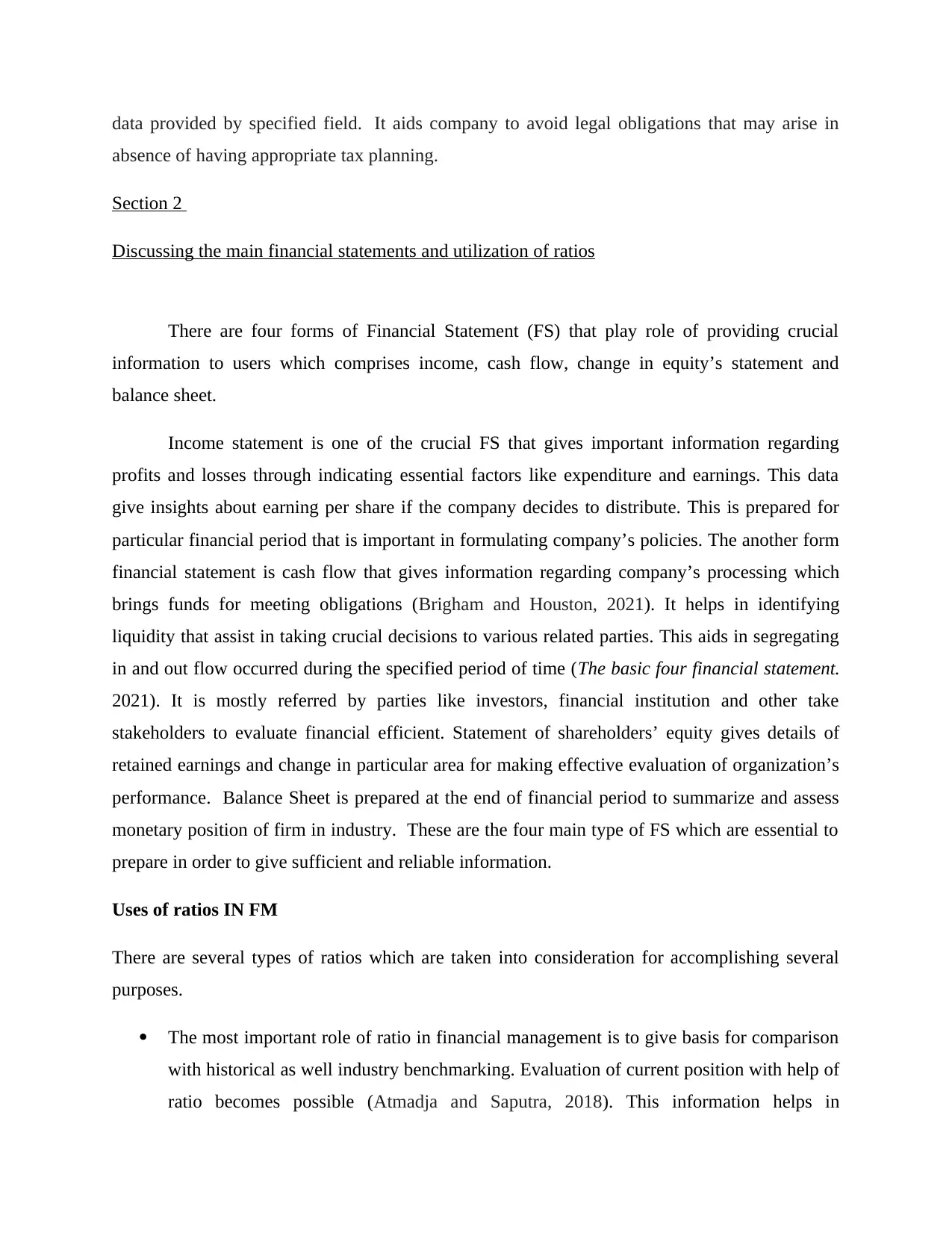
data provided by specified field. It aids company to avoid legal obligations that may arise in
absence of having appropriate tax planning.
Section 2
Discussing the main financial statements and utilization of ratios
There are four forms of Financial Statement (FS) that play role of providing crucial
information to users which comprises income, cash flow, change in equity’s statement and
balance sheet.
Income statement is one of the crucial FS that gives important information regarding
profits and losses through indicating essential factors like expenditure and earnings. This data
give insights about earning per share if the company decides to distribute. This is prepared for
particular financial period that is important in formulating company’s policies. The another form
financial statement is cash flow that gives information regarding company’s processing which
brings funds for meeting obligations (Brigham and Houston, 2021). It helps in identifying
liquidity that assist in taking crucial decisions to various related parties. This aids in segregating
in and out flow occurred during the specified period of time (The basic four financial statement.
2021). It is mostly referred by parties like investors, financial institution and other take
stakeholders to evaluate financial efficient. Statement of shareholders’ equity gives details of
retained earnings and change in particular area for making effective evaluation of organization’s
performance. Balance Sheet is prepared at the end of financial period to summarize and assess
monetary position of firm in industry. These are the four main type of FS which are essential to
prepare in order to give sufficient and reliable information.
Uses of ratios IN FM
There are several types of ratios which are taken into consideration for accomplishing several
purposes.
The most important role of ratio in financial management is to give basis for comparison
with historical as well industry benchmarking. Evaluation of current position with help of
ratio becomes possible (Atmadja and Saputra, 2018). This information helps in
absence of having appropriate tax planning.
Section 2
Discussing the main financial statements and utilization of ratios
There are four forms of Financial Statement (FS) that play role of providing crucial
information to users which comprises income, cash flow, change in equity’s statement and
balance sheet.
Income statement is one of the crucial FS that gives important information regarding
profits and losses through indicating essential factors like expenditure and earnings. This data
give insights about earning per share if the company decides to distribute. This is prepared for
particular financial period that is important in formulating company’s policies. The another form
financial statement is cash flow that gives information regarding company’s processing which
brings funds for meeting obligations (Brigham and Houston, 2021). It helps in identifying
liquidity that assist in taking crucial decisions to various related parties. This aids in segregating
in and out flow occurred during the specified period of time (The basic four financial statement.
2021). It is mostly referred by parties like investors, financial institution and other take
stakeholders to evaluate financial efficient. Statement of shareholders’ equity gives details of
retained earnings and change in particular area for making effective evaluation of organization’s
performance. Balance Sheet is prepared at the end of financial period to summarize and assess
monetary position of firm in industry. These are the four main type of FS which are essential to
prepare in order to give sufficient and reliable information.
Uses of ratios IN FM
There are several types of ratios which are taken into consideration for accomplishing several
purposes.
The most important role of ratio in financial management is to give basis for comparison
with historical as well industry benchmarking. Evaluation of current position with help of
ratio becomes possible (Atmadja and Saputra, 2018). This information helps in
Paraphrase This Document
Need a fresh take? Get an instant paraphrase of this document with our AI Paraphraser
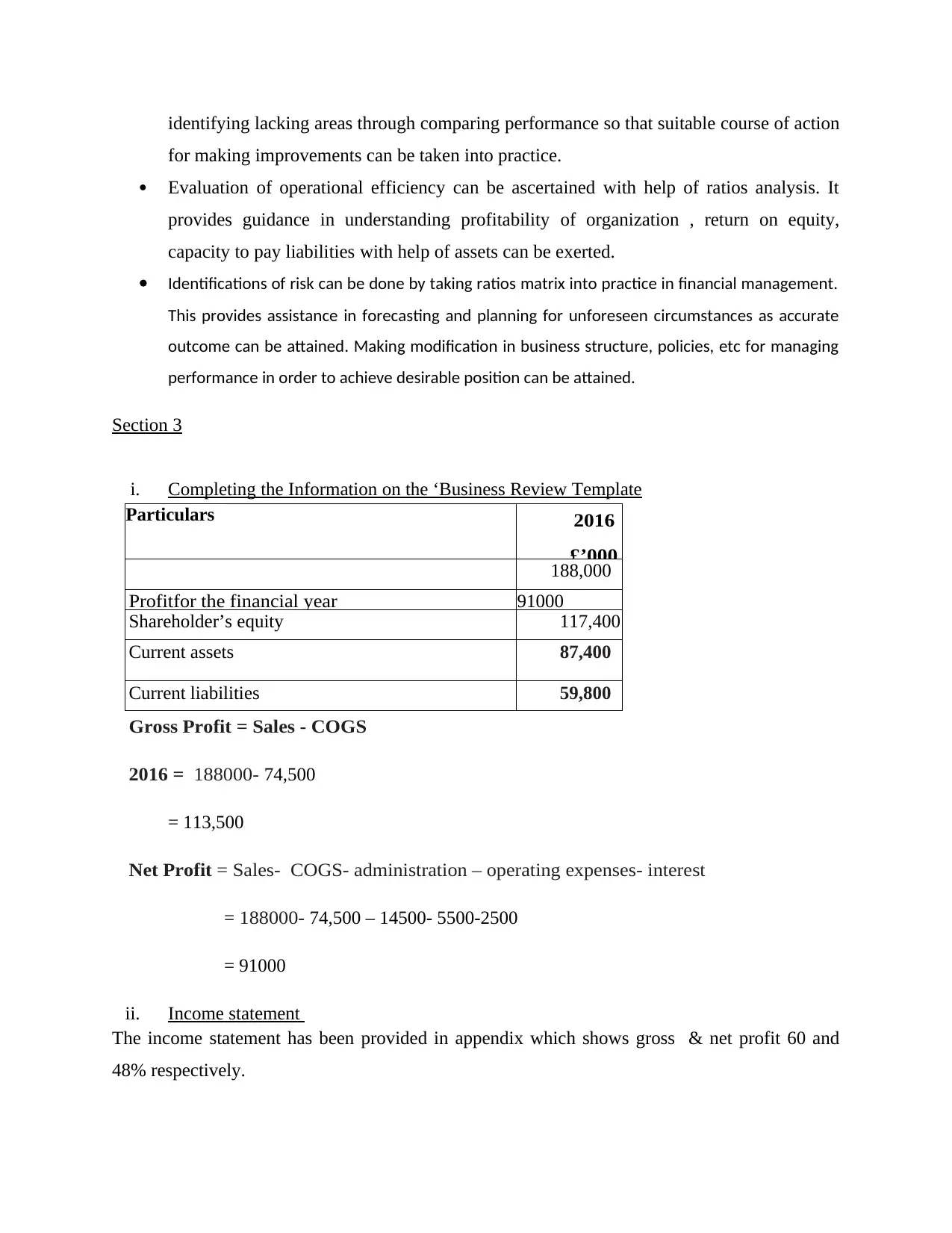
identifying lacking areas through comparing performance so that suitable course of action
for making improvements can be taken into practice.
Evaluation of operational efficiency can be ascertained with help of ratios analysis. It
provides guidance in understanding profitability of organization , return on equity,
capacity to pay liabilities with help of assets can be exerted.
Identifications of risk can be done by taking ratios matrix into practice in financial management.
This provides assistance in forecasting and planning for unforeseen circumstances as accurate
outcome can be attained. Making modification in business structure, policies, etc for managing
performance in order to achieve desirable position can be attained.
Section 3
i. Completing the Information on the ‘Business Review Template
Particulars 2016
£’000
188,000
Profitfor the financial year 91000
Shareholder’s equity 117,400
Current assets 87,400
Current liabilities 59,800
Gross Profit = Sales - COGS
2016 = 188000- 74,500
= 113,500
Net Profit = Sales- COGS- administration – operating expenses- interest
= 188000- 74,500 – 14500- 5500-2500
= 91000
ii. Income statement
The income statement has been provided in appendix which shows gross & net profit 60 and
48% respectively.
for making improvements can be taken into practice.
Evaluation of operational efficiency can be ascertained with help of ratios analysis. It
provides guidance in understanding profitability of organization , return on equity,
capacity to pay liabilities with help of assets can be exerted.
Identifications of risk can be done by taking ratios matrix into practice in financial management.
This provides assistance in forecasting and planning for unforeseen circumstances as accurate
outcome can be attained. Making modification in business structure, policies, etc for managing
performance in order to achieve desirable position can be attained.
Section 3
i. Completing the Information on the ‘Business Review Template
Particulars 2016
£’000
188,000
Profitfor the financial year 91000
Shareholder’s equity 117,400
Current assets 87,400
Current liabilities 59,800
Gross Profit = Sales - COGS
2016 = 188000- 74,500
= 113,500
Net Profit = Sales- COGS- administration – operating expenses- interest
= 188000- 74,500 – 14500- 5500-2500
= 91000
ii. Income statement
The income statement has been provided in appendix which shows gross & net profit 60 and
48% respectively.
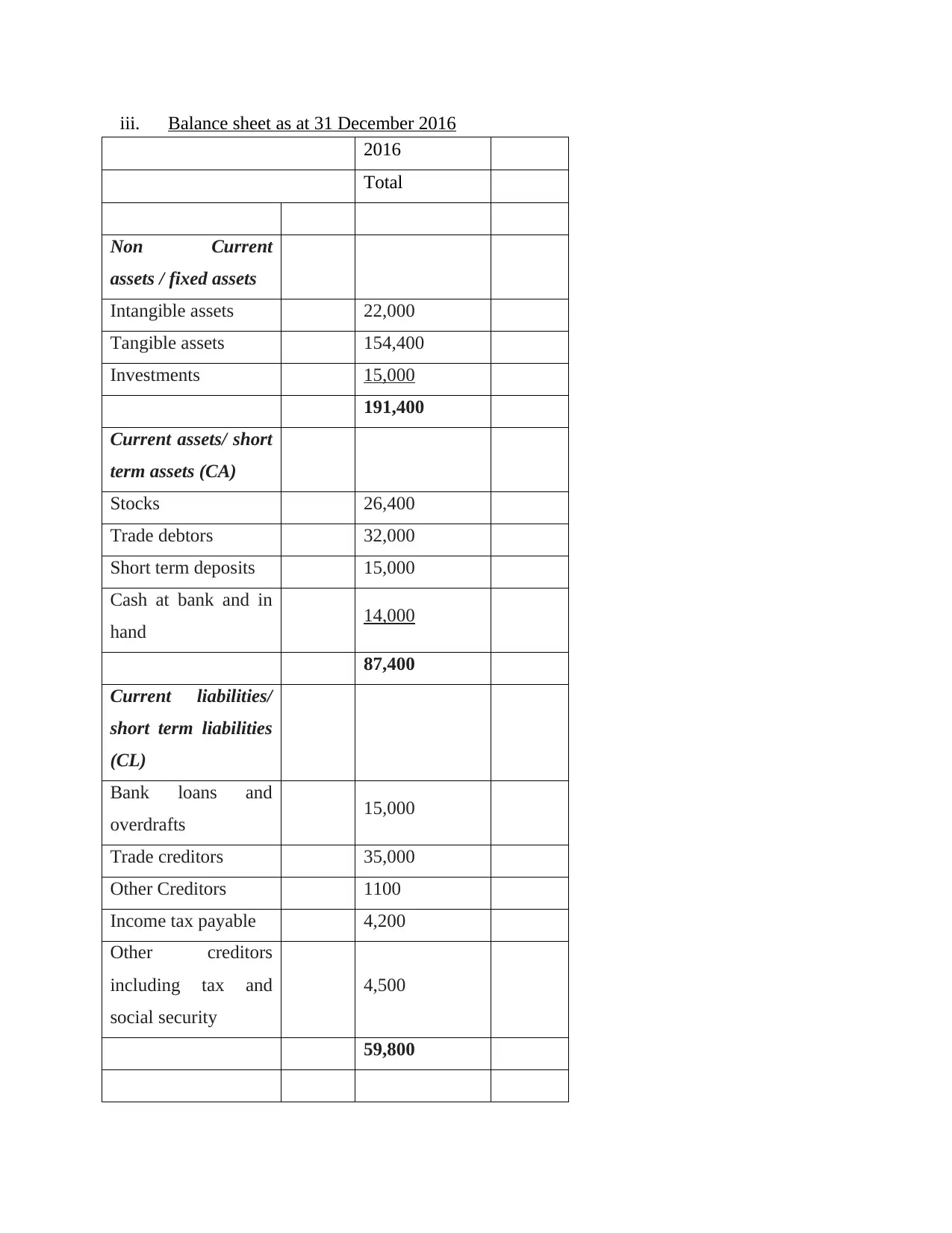
iii. Balance sheet as at 31 December 2016
2016
Total
Non Current
assets / fixed assets
Intangible assets 22,000
Tangible assets 154,400
Investments 15,000
191,400
Current assets/ short
term assets (CA)
Stocks 26,400
Trade debtors 32,000
Short term deposits 15,000
Cash at bank and in
hand 14,000
87,400
Current liabilities/
short term liabilities
(CL)
Bank loans and
overdrafts 15,000
Trade creditors 35,000
Other Creditors 1100
Income tax payable 4,200
Other creditors
including tax and
social security
4,500
59,800
2016
Total
Non Current
assets / fixed assets
Intangible assets 22,000
Tangible assets 154,400
Investments 15,000
191,400
Current assets/ short
term assets (CA)
Stocks 26,400
Trade debtors 32,000
Short term deposits 15,000
Cash at bank and in
hand 14,000
87,400
Current liabilities/
short term liabilities
(CL)
Bank loans and
overdrafts 15,000
Trade creditors 35,000
Other Creditors 1100
Income tax payable 4,200
Other creditors
including tax and
social security
4,500
59,800
⊘ This is a preview!⊘
Do you want full access?
Subscribe today to unlock all pages.

Trusted by 1+ million students worldwide
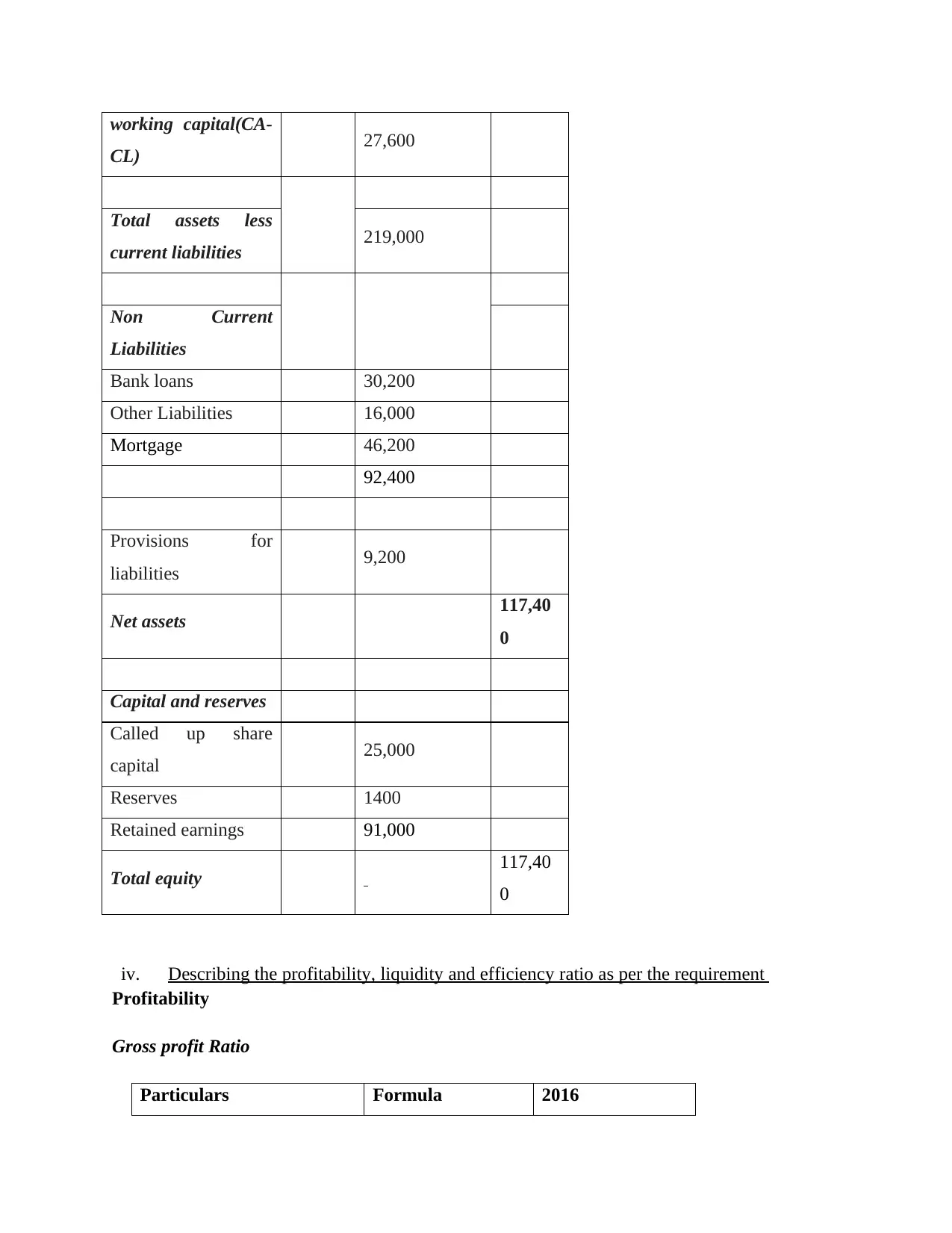
working capital(CA-
CL) 27,600
Total assets less
current liabilities 219,000
Non Current
Liabilities
Bank loans 30,200
Other Liabilities 16,000
Mortgage 46,200
92,400
Provisions for
liabilities 9,200
Net assets 117,40
0
Capital and reserves
Called up share
capital 25,000
Reserves 1400
Retained earnings 91,000
Total equity 117,40
0
iv. Describing the profitability, liquidity and efficiency ratio as per the requirement
Profitability
Gross profit Ratio
Particulars Formula 2016
CL) 27,600
Total assets less
current liabilities 219,000
Non Current
Liabilities
Bank loans 30,200
Other Liabilities 16,000
Mortgage 46,200
92,400
Provisions for
liabilities 9,200
Net assets 117,40
0
Capital and reserves
Called up share
capital 25,000
Reserves 1400
Retained earnings 91,000
Total equity 117,40
0
iv. Describing the profitability, liquidity and efficiency ratio as per the requirement
Profitability
Gross profit Ratio
Particulars Formula 2016
Paraphrase This Document
Need a fresh take? Get an instant paraphrase of this document with our AI Paraphraser
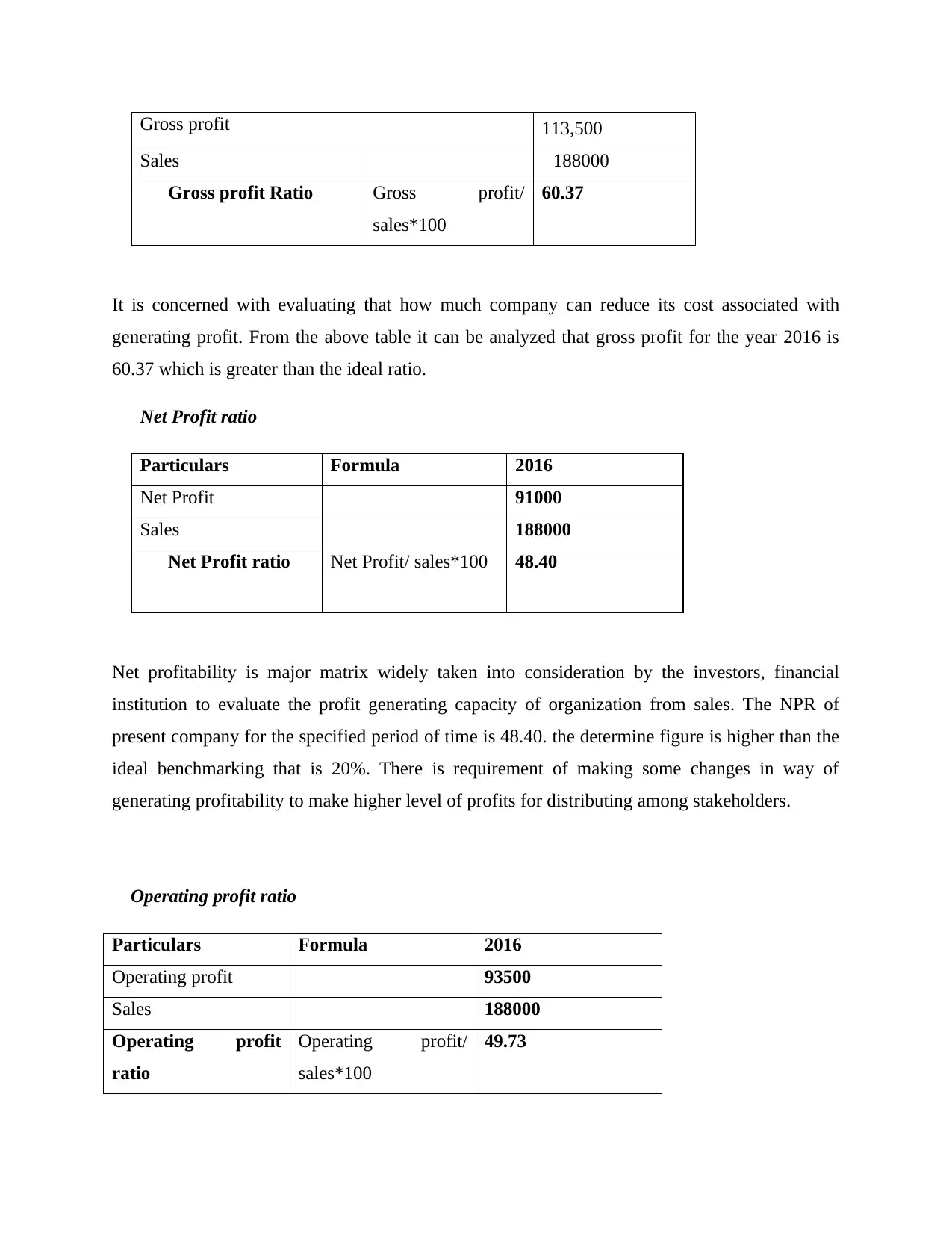
Gross profit 113,500
Sales 188000
Gross profit Ratio Gross profit/
sales*100
60.37
It is concerned with evaluating that how much company can reduce its cost associated with
generating profit. From the above table it can be analyzed that gross profit for the year 2016 is
60.37 which is greater than the ideal ratio.
Net Profit ratio
Particulars Formula 2016
Net Profit 91000
Sales 188000
Net Profit ratio Net Profit/ sales*100 48.40
Net profitability is major matrix widely taken into consideration by the investors, financial
institution to evaluate the profit generating capacity of organization from sales. The NPR of
present company for the specified period of time is 48.40. the determine figure is higher than the
ideal benchmarking that is 20%. There is requirement of making some changes in way of
generating profitability to make higher level of profits for distributing among stakeholders.
Operating profit ratio
Particulars Formula 2016
Operating profit 93500
Sales 188000
Operating profit
ratio
Operating profit/
sales*100
49.73
Sales 188000
Gross profit Ratio Gross profit/
sales*100
60.37
It is concerned with evaluating that how much company can reduce its cost associated with
generating profit. From the above table it can be analyzed that gross profit for the year 2016 is
60.37 which is greater than the ideal ratio.
Net Profit ratio
Particulars Formula 2016
Net Profit 91000
Sales 188000
Net Profit ratio Net Profit/ sales*100 48.40
Net profitability is major matrix widely taken into consideration by the investors, financial
institution to evaluate the profit generating capacity of organization from sales. The NPR of
present company for the specified period of time is 48.40. the determine figure is higher than the
ideal benchmarking that is 20%. There is requirement of making some changes in way of
generating profitability to make higher level of profits for distributing among stakeholders.
Operating profit ratio
Particulars Formula 2016
Operating profit 93500
Sales 188000
Operating profit
ratio
Operating profit/
sales*100
49.73
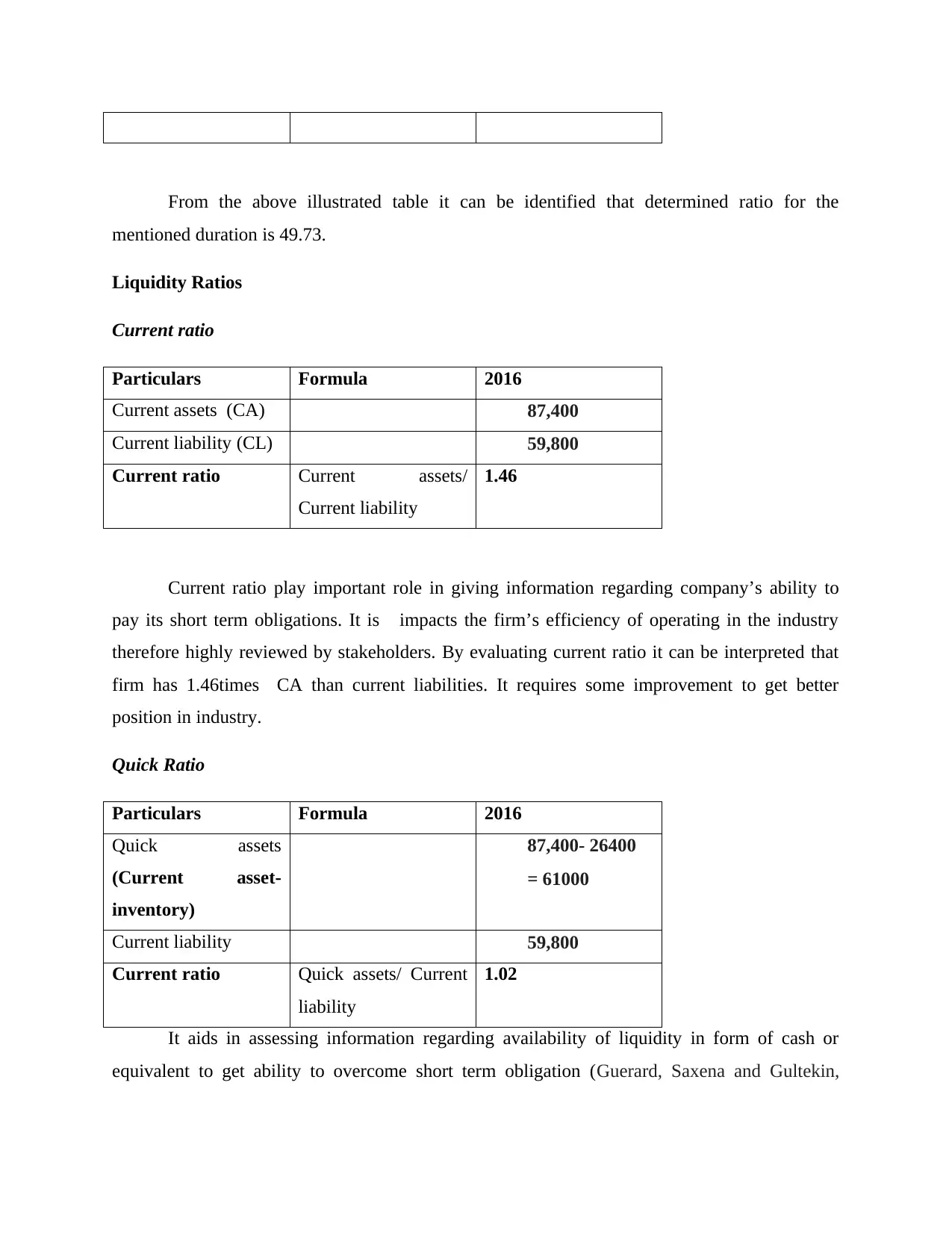
From the above illustrated table it can be identified that determined ratio for the
mentioned duration is 49.73.
Liquidity Ratios
Current ratio
Particulars Formula 2016
Current assets (CA) 87,400
Current liability (CL) 59,800
Current ratio Current assets/
Current liability
1.46
Current ratio play important role in giving information regarding company’s ability to
pay its short term obligations. It is impacts the firm’s efficiency of operating in the industry
therefore highly reviewed by stakeholders. By evaluating current ratio it can be interpreted that
firm has 1.46times CA than current liabilities. It requires some improvement to get better
position in industry.
Quick Ratio
Particulars Formula 2016
Quick assets
(Current asset-
inventory)
87,400- 26400
= 61000
Current liability 59,800
Current ratio Quick assets/ Current
liability
1.02
It aids in assessing information regarding availability of liquidity in form of cash or
equivalent to get ability to overcome short term obligation (Guerard, Saxena and Gultekin,
mentioned duration is 49.73.
Liquidity Ratios
Current ratio
Particulars Formula 2016
Current assets (CA) 87,400
Current liability (CL) 59,800
Current ratio Current assets/
Current liability
1.46
Current ratio play important role in giving information regarding company’s ability to
pay its short term obligations. It is impacts the firm’s efficiency of operating in the industry
therefore highly reviewed by stakeholders. By evaluating current ratio it can be interpreted that
firm has 1.46times CA than current liabilities. It requires some improvement to get better
position in industry.
Quick Ratio
Particulars Formula 2016
Quick assets
(Current asset-
inventory)
87,400- 26400
= 61000
Current liability 59,800
Current ratio Quick assets/ Current
liability
1.02
It aids in assessing information regarding availability of liquidity in form of cash or
equivalent to get ability to overcome short term obligation (Guerard, Saxena and Gultekin,
⊘ This is a preview!⊘
Do you want full access?
Subscribe today to unlock all pages.

Trusted by 1+ million students worldwide
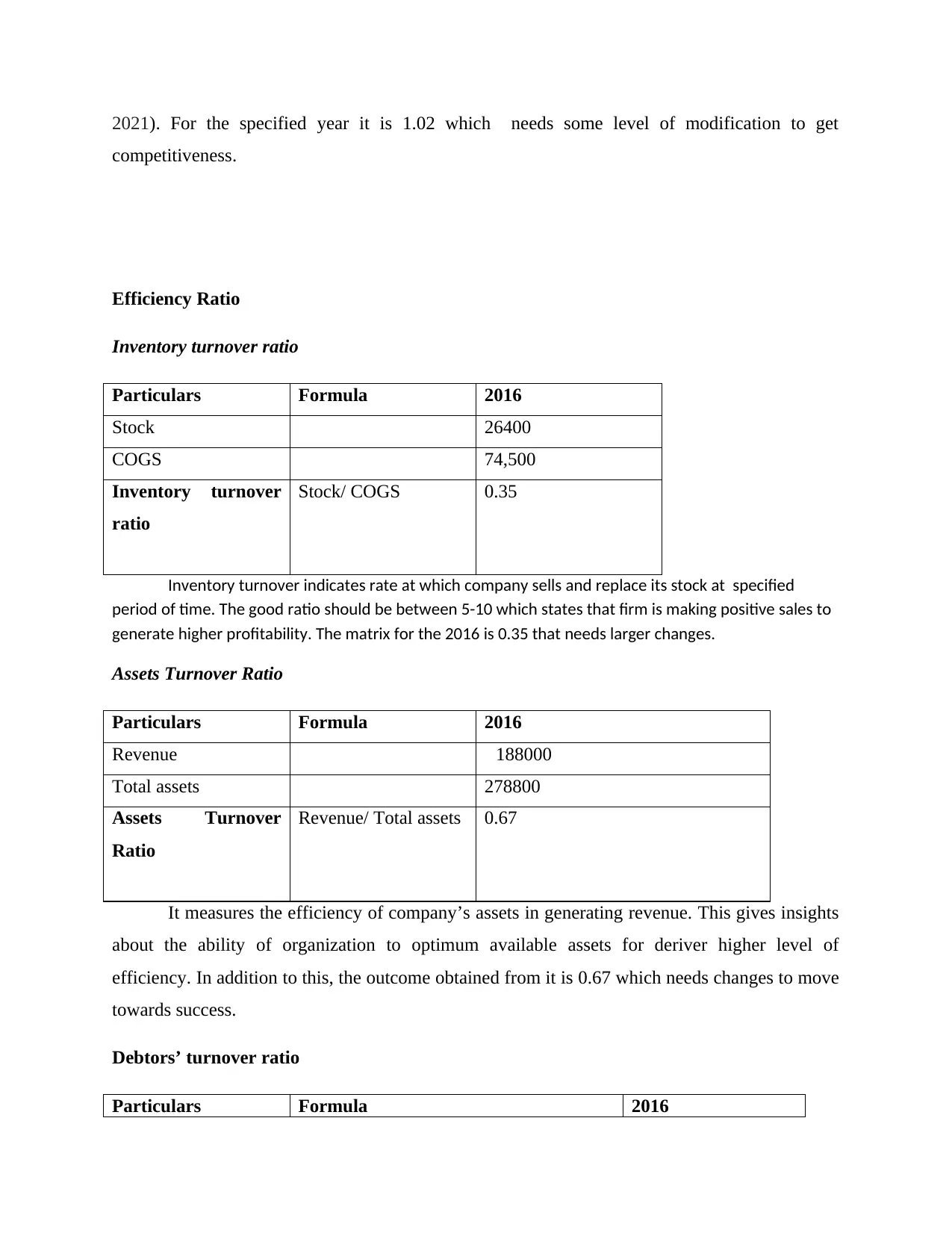
2021). For the specified year it is 1.02 which needs some level of modification to get
competitiveness.
Efficiency Ratio
Inventory turnover ratio
Particulars Formula 2016
Stock 26400
COGS 74,500
Inventory turnover
ratio
Stock/ COGS 0.35
Inventory turnover indicates rate at which company sells and replace its stock at specified
period of time. The good ratio should be between 5-10 which states that firm is making positive sales to
generate higher profitability. The matrix for the 2016 is 0.35 that needs larger changes.
Assets Turnover Ratio
Particulars Formula 2016
Revenue 188000
Total assets 278800
Assets Turnover
Ratio
Revenue/ Total assets 0.67
It measures the efficiency of company’s assets in generating revenue. This gives insights
about the ability of organization to optimum available assets for deriver higher level of
efficiency. In addition to this, the outcome obtained from it is 0.67 which needs changes to move
towards success.
Debtors’ turnover ratio
Particulars Formula 2016
competitiveness.
Efficiency Ratio
Inventory turnover ratio
Particulars Formula 2016
Stock 26400
COGS 74,500
Inventory turnover
ratio
Stock/ COGS 0.35
Inventory turnover indicates rate at which company sells and replace its stock at specified
period of time. The good ratio should be between 5-10 which states that firm is making positive sales to
generate higher profitability. The matrix for the 2016 is 0.35 that needs larger changes.
Assets Turnover Ratio
Particulars Formula 2016
Revenue 188000
Total assets 278800
Assets Turnover
Ratio
Revenue/ Total assets 0.67
It measures the efficiency of company’s assets in generating revenue. This gives insights
about the ability of organization to optimum available assets for deriver higher level of
efficiency. In addition to this, the outcome obtained from it is 0.67 which needs changes to move
towards success.
Debtors’ turnover ratio
Particulars Formula 2016
Paraphrase This Document
Need a fresh take? Get an instant paraphrase of this document with our AI Paraphraser
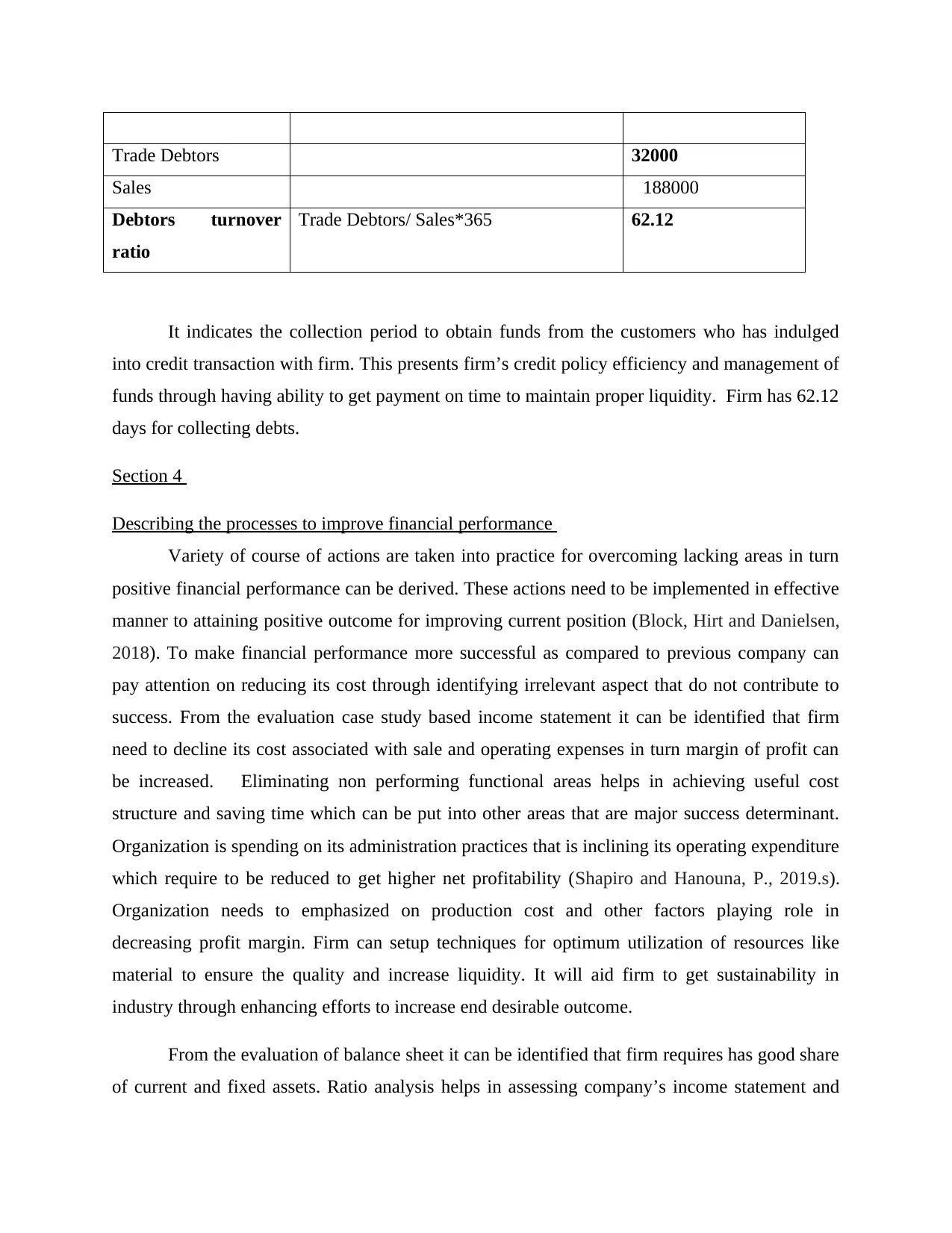
Trade Debtors 32000
Sales 188000
Debtors turnover
ratio
Trade Debtors/ Sales*365 62.12
It indicates the collection period to obtain funds from the customers who has indulged
into credit transaction with firm. This presents firm’s credit policy efficiency and management of
funds through having ability to get payment on time to maintain proper liquidity. Firm has 62.12
days for collecting debts.
Section 4
Describing the processes to improve financial performance
Variety of course of actions are taken into practice for overcoming lacking areas in turn
positive financial performance can be derived. These actions need to be implemented in effective
manner to attaining positive outcome for improving current position (Block, Hirt and Danielsen,
2018). To make financial performance more successful as compared to previous company can
pay attention on reducing its cost through identifying irrelevant aspect that do not contribute to
success. From the evaluation case study based income statement it can be identified that firm
need to decline its cost associated with sale and operating expenses in turn margin of profit can
be increased. Eliminating non performing functional areas helps in achieving useful cost
structure and saving time which can be put into other areas that are major success determinant.
Organization is spending on its administration practices that is inclining its operating expenditure
which require to be reduced to get higher net profitability (Shapiro and Hanouna, P., 2019.s).
Organization needs to emphasized on production cost and other factors playing role in
decreasing profit margin. Firm can setup techniques for optimum utilization of resources like
material to ensure the quality and increase liquidity. It will aid firm to get sustainability in
industry through enhancing efforts to increase end desirable outcome.
From the evaluation of balance sheet it can be identified that firm requires has good share
of current and fixed assets. Ratio analysis helps in assessing company’s income statement and
Sales 188000
Debtors turnover
ratio
Trade Debtors/ Sales*365 62.12
It indicates the collection period to obtain funds from the customers who has indulged
into credit transaction with firm. This presents firm’s credit policy efficiency and management of
funds through having ability to get payment on time to maintain proper liquidity. Firm has 62.12
days for collecting debts.
Section 4
Describing the processes to improve financial performance
Variety of course of actions are taken into practice for overcoming lacking areas in turn
positive financial performance can be derived. These actions need to be implemented in effective
manner to attaining positive outcome for improving current position (Block, Hirt and Danielsen,
2018). To make financial performance more successful as compared to previous company can
pay attention on reducing its cost through identifying irrelevant aspect that do not contribute to
success. From the evaluation case study based income statement it can be identified that firm
need to decline its cost associated with sale and operating expenses in turn margin of profit can
be increased. Eliminating non performing functional areas helps in achieving useful cost
structure and saving time which can be put into other areas that are major success determinant.
Organization is spending on its administration practices that is inclining its operating expenditure
which require to be reduced to get higher net profitability (Shapiro and Hanouna, P., 2019.s).
Organization needs to emphasized on production cost and other factors playing role in
decreasing profit margin. Firm can setup techniques for optimum utilization of resources like
material to ensure the quality and increase liquidity. It will aid firm to get sustainability in
industry through enhancing efforts to increase end desirable outcome.
From the evaluation of balance sheet it can be identified that firm requires has good share
of current and fixed assets. Ratio analysis helps in assessing company’s income statement and
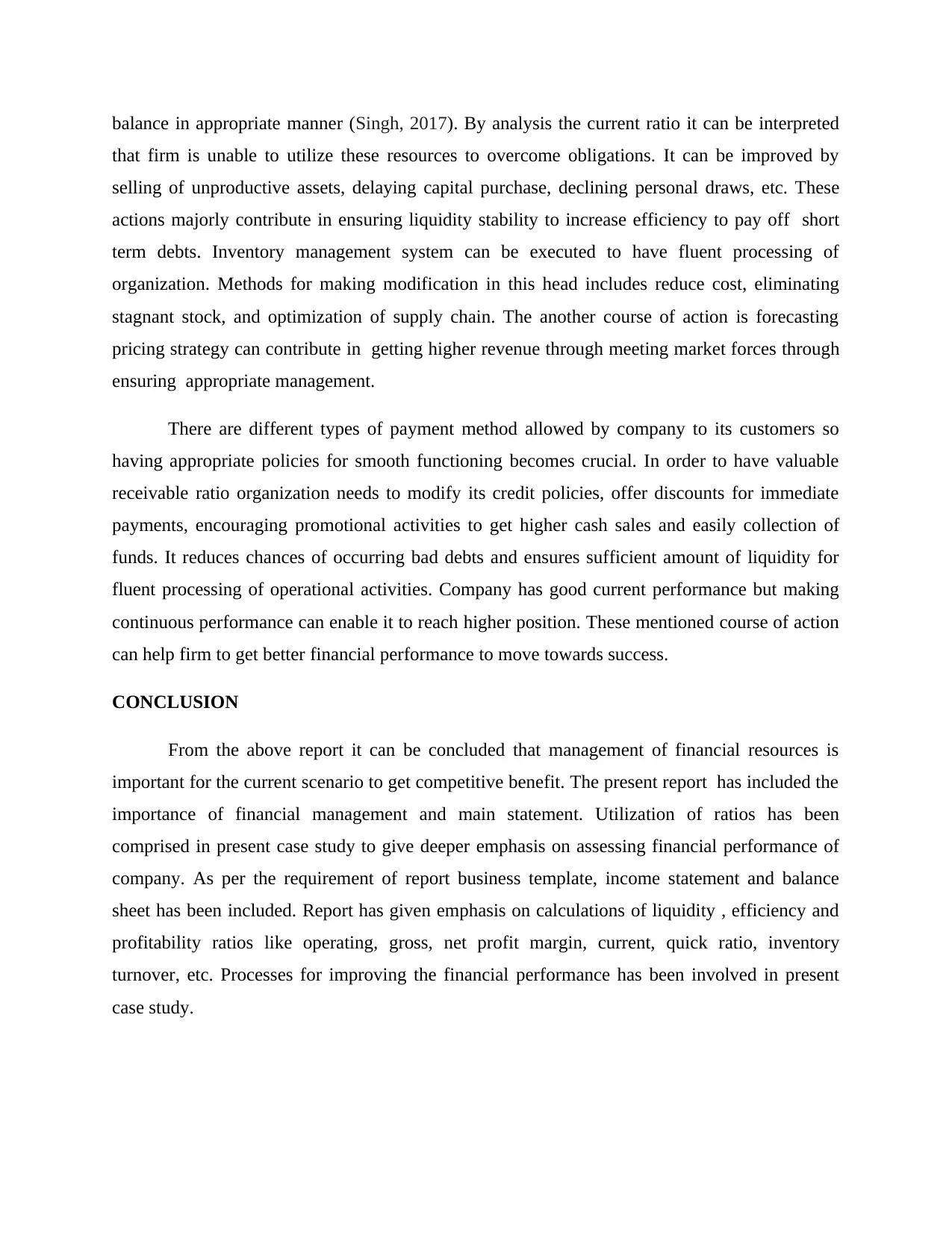
balance in appropriate manner (Singh, 2017). By analysis the current ratio it can be interpreted
that firm is unable to utilize these resources to overcome obligations. It can be improved by
selling of unproductive assets, delaying capital purchase, declining personal draws, etc. These
actions majorly contribute in ensuring liquidity stability to increase efficiency to pay off short
term debts. Inventory management system can be executed to have fluent processing of
organization. Methods for making modification in this head includes reduce cost, eliminating
stagnant stock, and optimization of supply chain. The another course of action is forecasting
pricing strategy can contribute in getting higher revenue through meeting market forces through
ensuring appropriate management.
There are different types of payment method allowed by company to its customers so
having appropriate policies for smooth functioning becomes crucial. In order to have valuable
receivable ratio organization needs to modify its credit policies, offer discounts for immediate
payments, encouraging promotional activities to get higher cash sales and easily collection of
funds. It reduces chances of occurring bad debts and ensures sufficient amount of liquidity for
fluent processing of operational activities. Company has good current performance but making
continuous performance can enable it to reach higher position. These mentioned course of action
can help firm to get better financial performance to move towards success.
CONCLUSION
From the above report it can be concluded that management of financial resources is
important for the current scenario to get competitive benefit. The present report has included the
importance of financial management and main statement. Utilization of ratios has been
comprised in present case study to give deeper emphasis on assessing financial performance of
company. As per the requirement of report business template, income statement and balance
sheet has been included. Report has given emphasis on calculations of liquidity , efficiency and
profitability ratios like operating, gross, net profit margin, current, quick ratio, inventory
turnover, etc. Processes for improving the financial performance has been involved in present
case study.
that firm is unable to utilize these resources to overcome obligations. It can be improved by
selling of unproductive assets, delaying capital purchase, declining personal draws, etc. These
actions majorly contribute in ensuring liquidity stability to increase efficiency to pay off short
term debts. Inventory management system can be executed to have fluent processing of
organization. Methods for making modification in this head includes reduce cost, eliminating
stagnant stock, and optimization of supply chain. The another course of action is forecasting
pricing strategy can contribute in getting higher revenue through meeting market forces through
ensuring appropriate management.
There are different types of payment method allowed by company to its customers so
having appropriate policies for smooth functioning becomes crucial. In order to have valuable
receivable ratio organization needs to modify its credit policies, offer discounts for immediate
payments, encouraging promotional activities to get higher cash sales and easily collection of
funds. It reduces chances of occurring bad debts and ensures sufficient amount of liquidity for
fluent processing of operational activities. Company has good current performance but making
continuous performance can enable it to reach higher position. These mentioned course of action
can help firm to get better financial performance to move towards success.
CONCLUSION
From the above report it can be concluded that management of financial resources is
important for the current scenario to get competitive benefit. The present report has included the
importance of financial management and main statement. Utilization of ratios has been
comprised in present case study to give deeper emphasis on assessing financial performance of
company. As per the requirement of report business template, income statement and balance
sheet has been included. Report has given emphasis on calculations of liquidity , efficiency and
profitability ratios like operating, gross, net profit margin, current, quick ratio, inventory
turnover, etc. Processes for improving the financial performance has been involved in present
case study.
⊘ This is a preview!⊘
Do you want full access?
Subscribe today to unlock all pages.

Trusted by 1+ million students worldwide
1 out of 16
Related Documents
Your All-in-One AI-Powered Toolkit for Academic Success.
+13062052269
info@desklib.com
Available 24*7 on WhatsApp / Email
![[object Object]](/_next/static/media/star-bottom.7253800d.svg)
Unlock your academic potential
Copyright © 2020–2025 A2Z Services. All Rights Reserved. Developed and managed by ZUCOL.



